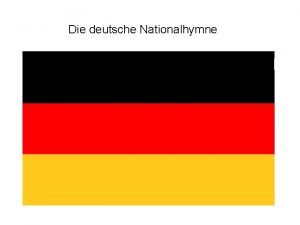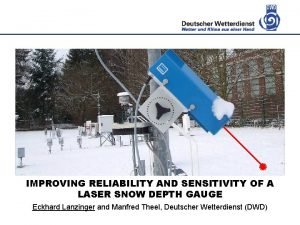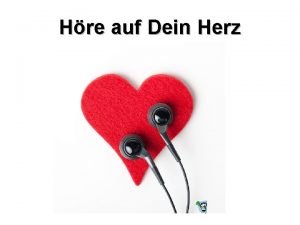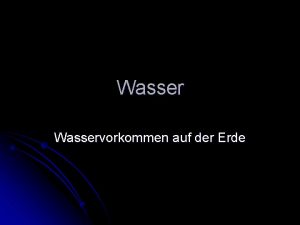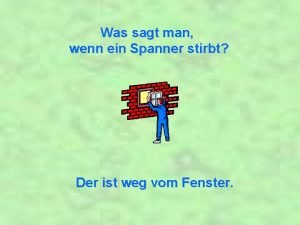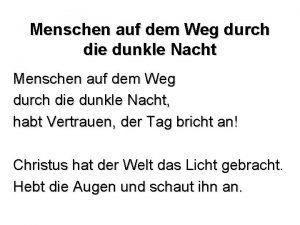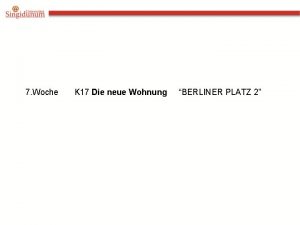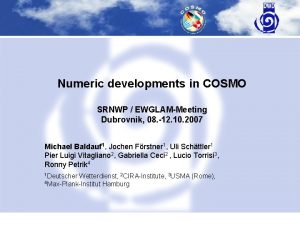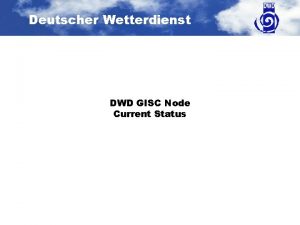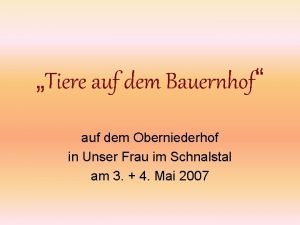Deutscher Wetterdienst Titelfoto auf dem Titelmaster einfgen IMPROVING







- Slides: 7

Deutscher Wetterdienst Titelfoto auf dem Titelmaster einfügen IMPROVING RELIABILITY AND SENSITIVITY OF A LASER SNOW DEPTH GAUGE Eckhard Lanzinger and Manfred Theel, Deutscher Wetterdienst (DWD)

Comparison of ultrasonic and laser snow depth gauges è Campbell SR 50 G (ultrasonic) ■ sonic cone with angle of aperture: 12° ■ vertical measurement ■ measurement uncertainty: 1% of distance ■ needs temperature compensation ■ sensitive to snowfall and wind è Jenoptik SHM 30 (laser) ■ small red laser beam ■ slanted measurement at an angle of 30° ■ measurement uncertainty: < 0. 5 cm ■ no temperature compensation needed ■ insensitive to snowfall and wind Laser gauge provides backscatter signal DWD / E. Lanzinger Experimental setup TECO-2010, 30. August – 1. September 2010, Helsinki, Finland

Snowfall event on 23. January 2009 (Hamburg) 12: 07 Onset of light / moderate snowfall wawa (Tab. 4680) 13: 05 SHM 30 signal strength > 3. 5 SHM 30 backscatter signal SHM 30 snow depth 14: 15 SHM 30 – snow depth > 0. 5 cm SR 50 (corrected 5 minute mean) 17: 14 SR 50 - snow depth ≥ 1 cm Backscatter signal allows early detection of snow cover DWD / E. Lanzinger TECO-2010, 30. August – 1. September 2010, Helsinki, Finland

Operational Experience è Backscatter signal varies from gauge to gauge. Signal level should be calibrated and adjusted at the factory è Grey snow plate improves snow cover detection è Heating of housing has to be improved for icing conditions è Visible laser point can attract birds Comparison of two Laser snow depth gauges JENOPTIK SHM 30. Icing problem of JENOPTIK SHM 30. DWD / E. Lanzinger TECO-2010, 30. August – 1. September 2010, Helsinki, Finland

Operational Experience Both laser points were about 10 cm apart Very good correlation of two laser gauges and no zero drift DWD / E. Lanzinger TECO-2010, 30. August – 1. September 2010, Helsinki, Finland

Multipoint Measurement è Manufacturers should think about a scanning laser snow depth gauge to cover larger areas DWD / E. Lanzinger TECO-2010, 30. August – 1. September 2010, Helsinki, Finland

Conclusions è Positive features of Laser snow depth gauges ■ Slanted measurement with high accuracy ■ Practically independent of air temperature and wind ■ No drop outs even during heavy snowfall è Detection of snow cover by backscatter signal ■ Sensitivity increased ■ Reliability of snow depth measurement increased è Possible improvements ■ Backscatter signal strength has to be calibrated ■ Multipoint measurements Thank you for your attention! DWD / E. Lanzinger TECO-2010, 30. August – 1. September 2010, Helsinki, Finland
